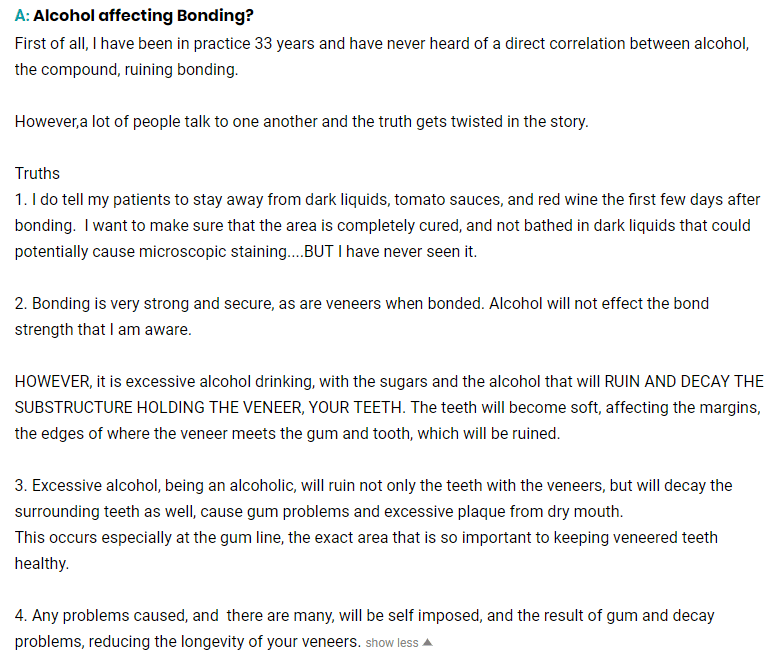Although direct composite veneers were introduced in the late 1970s, yet, they were dissatisfying due to poor wear, color stability, and retention of polished surfaces. Today’s composites have much improved physical as well as aesthetic properties. They are obtainable with minimally invasive techniques and also immediate results satisfying the larger segment of patients seeking cosmetic treatments. Porcelain veneers, on the other hand, require some more and also an irreversible tooth intervention.
- Proper Cleaning
- Using The Right Toothpaste
- Careful With The Bite
- Avoiding Hard Foods
- Avoiding Acidic Foods
- Avoid Staining Foods
- Quit Smoking
- Avoid Too Much Alcohol
- Address Teeth Grinding
- Choose Your Toothbrush
The decision-making factor for veneers:
Over the years, dental candidates seeking a cosmetic makeover of their smile, have gone with veneers. A recent study on the effect of veneers on cosmetic improvement has revealed the following :
The four hypotheses that were tested:
- Composite resin and porcelain veneers have the same cosmetic effect in terms of patient assessment.
- Patients choose composite veneers as an alternative to porcelain veneers mainly due to tooth conservation, cost and it being a one-visit procedure.
- Patients choose porcelain veneers as an alternative to composite veneers mainly due to long-term performance even after considering postoperative side-effects and irreversible tooth reduction.
- Patient satisfaction for overall cosmetic improvement is multi-factorial.
Getting a veneer treatment for your teeth is not enough. You need to maintain them and that maintenance involves a great deal. Your veneers are positively supposed to be long-lasting if you are more or less adhering to the following:
Proper cleaning:
Your veneers should be cleaned as much as your real teeth. Brushing at least twice a day and using dental floss are both effective ways. Poor dental hygiene leads to gum diseases. It may cause your gums to recede thus exposing the borders of veneers, putting them at the risk of chipping or falling off!
Using the right toothpaste:
If you are planning to use whitening toothpastes, just know that they are not at all necessary. They could be too abrasive for your veneers. Whitening pastes may contain substances like hydrogen peroxide and sodium bicarbonate (baking soda). They will sooner or later, eat away at your veneer’s surface or destroy its color and sheen. It is wiser to use gel products on the contrary, as they do have such ingredients.
Careful with the bite:
To put it straight, veneers are not as strong as natural teeth. Hence, chewing on very hard objects, such as pens, ice, nails, bones, etc. is strictly prohibited as far as protecting your veneers is concerned. Although it is unlikely, your veneers may chip if you chew on these or other hard objects, yet, if you have the habit of biting into random things, you need to attempt to end such mannerisms.
Avoiding hard foods:
The hard stuff that are being talked about, includes raw carrots, raw apples, peanuts, meat bones etc. They might destroy your costly veneers!
Avoiding acidic food:
Foods that contain lots of sugar and acid needs to be partly put away too. These foods contribute to tooth decay and are not good for your veneers either.
Avoid staining foods:
Although porcelain veneers are able to resist stains, they do become stained over time. They behave quite like your natural teeth and so you need to be equally careful. Avoid stain-causing foods and beverages like coffee, tea, red wine, soy sauce, berries, etc.
Quit Smoking:
Another common cause of discoloration is smoking. Positively consider quitting tobacco for the sake of your teeth as well as the veneers.
Avoid too much alcohol:
Taking a lot of alcohol will soften the bonding composites that hold the veneers to your teeth. While this doesn’t imply that the veneers will come loose, it will make the bonding line more prone to damage and stains. While buying mouthwash or toothpaste, check the ingredients to see if they contain alcohol because these can be just as damaging as liquor.

Address teeth grinding:
Bruxism places a great amount of stress on your teeth, considerably damaging your veneers along with your natural teeth. In such a case you may need to wear a bite guard or an occlusal guard. The device will minimize the stress placed on your teeth while you sleep if you are a teeth grinder.
Choose your toothbrush:
Your tooth laminates are held in place using a special bonding agent. Post a cosmetic treatment, you must allow a week or two for the bonding effect to set in. Even after this initial period, you must brush your teeth with a soft-bristled toothbrush and gentle whitening toothpaste – that preferably removes stains without any abrasive action.
You may like to read also:4 Things You Must Know Before Using Veneers


